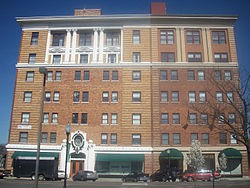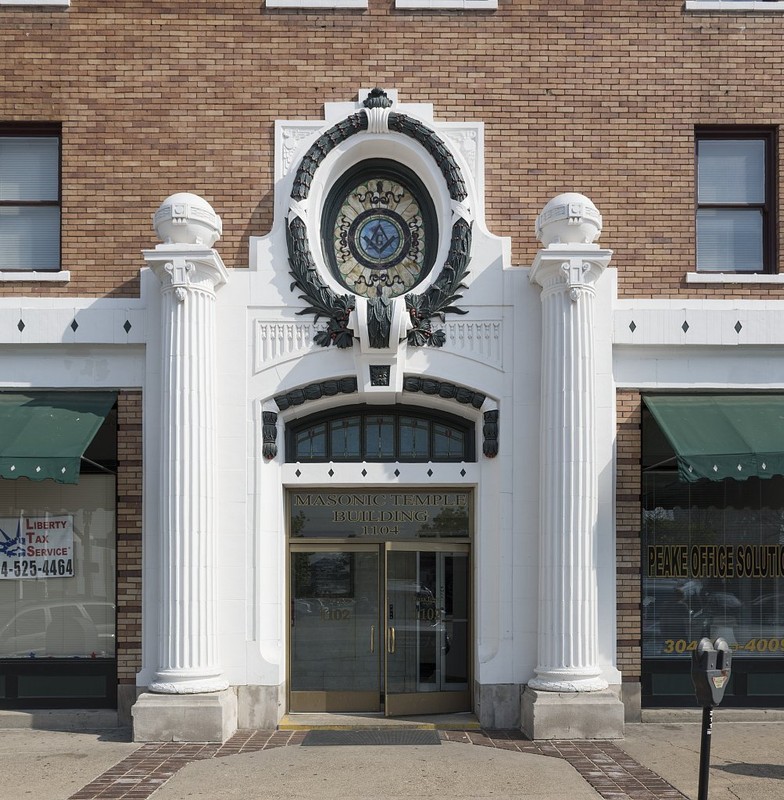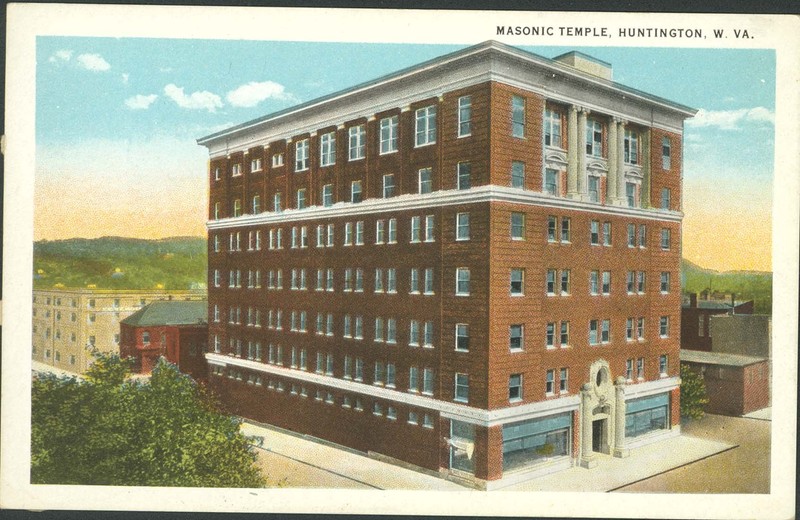Masonic Temple - Watts, Ritter Wholesale Dry Goods Co. Building
Introduction
Text-to-speech Audio
Images
The building was constructed in two phases, with the western half built in 1914 and the eastern half built in 1922.

The front entrance of the building features some ornamentation to reflect its status as a Masonic Temple. Image courtesy of the Library of Congress.

This early postcard of the Masonic Temple shows the building before the construction of the eastern half in 1922. Image courtesy of Marshall University Special Collections .

Backstory and Context
Text-to-speech Audio
The Freemason Huntington Lodge No. 53 was organized in 1872; only a year after the city was incorporated. The Freemasons were one of several national fraternal organizations to establish branches during Huntington’s early decades. Others included the Elks Lodge and the Independent Order of Odd Fellows. For its first forty years the Lodge held meetings at varying locations around the city. In 1909 it purchased a plot of land at the corner of Third Avenue and Eleventh Street for $15,000. The property had previously been used as a bicycle sales lot. In 1912 a seven-story building was constructed on the site to serve as a permanent Masonic Temple. Columbus, Ohio architect Wilbur T. Mills was chosen to design the building; his other notable works included the Columbus Carnegie Public Library. The Masonic Temple was completed and dedicated in 1914 at a cost of $200,000. The top two floors were reserved for Freemason activities, while the remaining five floors were quickly rented by the Watts, Ritter Wholesale Drygoods Company.
Watts, Ritter & Co. traces back to 1892 with the founding of the Barlow-Henderson Company. Originally headed by B. F. Barlow, it was one of the earliest wholesale businesses in Huntington. Wholesale stores, also known as jobbing houses, acquired merchandise in bulk and then sold that to retailers in the surrounding area. Huntington became an ideal location for wholesale businesses in the late 1800s as manufacturing industries grew and transportation was readily available. Many of the wholesale businesses in Huntington sold their goods to stores in coal mining communities around the region.
The Barlow-Henderson Company erected a seven-story building in 1895, but it was destroyed in a massive fire in 1905. The following year the business was taken over by Charles W. Watts and C. Lloyd Ritter, and the name was changed to Watts, Ritter & Co. In 1914 the company moved into the first five floors of the Masonic Temple, using it as both a warehouse and office space. Watts, Ritter & Co. prospered during the following years and eventually outgrew the space. In 1922 it built a five-story annex on the east side of the Masonic Temple; two more stories were added in 1926. The new addition was more simplistic in design than the original portion but still blended in well. In 1930 Watts, Ritter & Co. was purchased by Ely & Walker of St. Louis, Missouri, but the same name was kept. In 1959 Ely & Walker consolidated some of their operations nationwide, which resulted in Watts, Ritter & Co. being shuttered.
Much of the building remained vacant for many years, until it was purchased by Tom Way and Dave Ferguson in 1989. Together the pair invested two million dollars to refurbish the structure and transform it into a contemporary, upscale office building. The new changes included the addition of more windows and the construction of a rooftop patio for gatherings. The building reopened in 1990 under the name River Tower and became home to law firms and other businesses. River Tower notably hosted the movie wrap party for the premier of the 2006 film We Are Marshall; Matthew McConaghey and other actors from the movie reportedly attended. The Masonic Lodge continues to operate from the top floors of the building’s western half as well.
Sources
Casto, James E. “Lost Huntington: Watts, Ritter & Co.” Herald-Dispatch. April 23, 2018. Accessed July 5, 2019. https://www.herald-dispatch.com/special/lost_huntington/lost-huntington-watts-ritter-co/article_d1100f47-5807-5776-8d15-f3d57e24d71e.html.
Highsmith, Carol M, photographer. Entrance to the Huntington, West Virginia, Masonic temple. Huntington United States West Virginia, 2015. -05-07. Photograph. https://www.loc.gov/item/2015631807/.
McMillan, Don Daniel. Images of America: Huntington. Charleston, SC: Arcadia Publishing, 2003.
Recchie, Nancy. “Masonic Temple/Watts, Ritter Wholesale Drygoods Company Building.” National Register of Historic Places Registration Form. March 1993. Accessed July 5, 2019. http://www.wvculture.org/shpo/nr/pdf/cabell/93000614.pdf.
Rosenberger, Bill. “River Tower has provided high-class offices for 20 years.” Herald-Dispatch. December 12, 2010. Accessed July 5, 2019. https://www.herald-dispatch.com/business/river-tower-has-provided-high-class-offices-for-years/article_7759622e-e2de-5e41-bdc9-da53f759b114.html.
